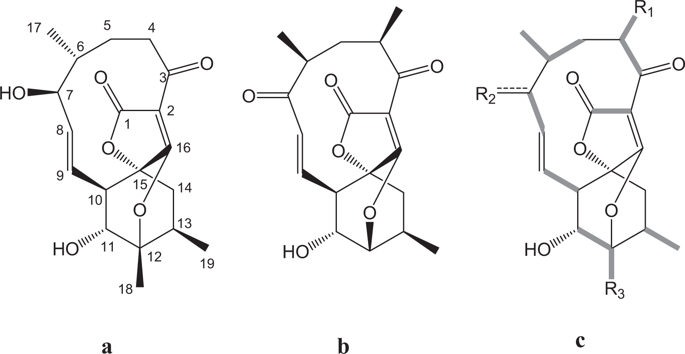当前位置:
X-MOL 学术
›
J. Antibiot.
›
论文详情
Our official English website, www.x-mol.net, welcomes your
feedback! (Note: you will need to create a separate account there.)
Diversity of PKS and NRPS gene clusters between Streptomyces abyssomicinicus sp. nov. and its taxonomic neighbor.
The Journal of Antibiotics ( IF 2.1 ) Pub Date : 2019-12-18 , DOI: 10.1038/s41429-019-0261-1 Hisayuki Komaki 1 , Kenta Sakurai 2 , Akira Hosoyama 2 , Akane Kimura 2 , Martha E Trujilo 3 , Yasuhiro Igarashi 4 , Tomohiko Tamura 1
The Journal of Antibiotics ( IF 2.1 ) Pub Date : 2019-12-18 , DOI: 10.1038/s41429-019-0261-1 Hisayuki Komaki 1 , Kenta Sakurai 2 , Akira Hosoyama 2 , Akane Kimura 2 , Martha E Trujilo 3 , Yasuhiro Igarashi 4 , Tomohiko Tamura 1
Affiliation

|
Streptomyces sp. CHI39, isolated from a rock soil sample, is a producer of abyssomicin I. The taxonomic status was clarified by a polyphasic approach. Phylogenetic analysis based on 16S rRNA gene sequences showed that the strain was closely related to Streptomyces fragilis, with similarity of 99.9%. Strain CHI39 comprised LL-diaminopimelic acid, glutamic acid, glycine, and alanine in its peptidoglycan. The predominant menaquinones were MK-9(H6), and major fatty acids were anteiso-C15:0, anteiso-C17:0, and iso-C16:0. The chemotaxonomic features matched those described for the genus Streptomyces. Genome sequencing was conducted for strain CHI39 and S. fragilis NBRC 12862T. The results of digital DNA-DNA hybridization along with differences in phenotypic characteristics between the strains suggested strain CHI39 to be a novel species, for which Streptomyces abyssomicinicus sp. nov. is proposed; the type strain is CHI39T (=NBRC 110469T). Next, we surveyed polyketide synthase (PKS) and nonribosomal peptide synthetase (NRPS) gene clusters in genomes of S. abyssomicinicus CHI39T and S. fragilis NBRC 12862T. These strains encoded 9 and 12 clusters, respectively, among which only four clusters were shared between them while the others are specific in each strain. This suggests that strains classified to distinct species each harbor many specific secondary metabolite-biosynthetic pathways even if the strains are taxonomically close.
中文翻译:

Abyssomicinicus sp。之间的PKS和NRPS基因簇的多样性。十一月 及其分类邻居。
链霉菌 从岩石土壤样品中分离出的CHI39是Asssomicin I的生产者。通过多相方法可以明确分类学地位。基于16S rRNA基因序列的系统进化分析表明,该菌株与脆弱链霉菌密切相关,相似度为99.9%。菌株CHI39在其肽聚糖中包含LL-二氨基庚二酸,谷氨酸,甘氨酸和丙氨酸。主要的甲基萘醌为MK-9(H6),主要脂肪酸为前异C15:0,前异C17:0和异C16:0。化学分类学特征与链霉菌属描述的那些相匹配。对菌株CHI39和脆弱的链球菌NBRC 12862T进行了基因组测序。数字DNA-DNA杂交的结果以及菌株之间的表型特征差异表明,CHI39菌株是一种新种,为此,链霉菌深渊菌。十一月 被提议; 类型菌株为CHI39T(= NBRC 110469T)。接下来,我们调查了深渊链球菌CHI39T和脆弱型链球菌NBRC 12862T基因组中的聚酮化合物合酶(PKS)和非核糖体肽合成酶(NRPS)基因簇。这些菌株分别编码9和12个簇,其中只有4个簇在它们之间共享,而其他簇在每种菌株中是特异性的。这表明分类为不同物种的菌株每个都具有许多特定的次级代谢产物生物合成途径,即使该菌株在分类学上很接近。这些菌株分别编码9和12个簇,其中只有4个簇在它们之间共享,而其他簇在每种菌株中是特异性的。这表明分类为不同物种的菌株每个都具有许多特定的次级代谢产物生物合成途径,即使该菌株在分类学上很接近。这些菌株分别编码9和12个簇,其中只有4个簇在它们之间共享,而其他簇在每种菌株中是特异性的。这表明分类为不同物种的菌株每个都具有许多特定的次级代谢产物生物合成途径,即使该菌株在分类学上很接近。
更新日期:2019-12-18
中文翻译:

Abyssomicinicus sp。之间的PKS和NRPS基因簇的多样性。十一月 及其分类邻居。
链霉菌 从岩石土壤样品中分离出的CHI39是Asssomicin I的生产者。通过多相方法可以明确分类学地位。基于16S rRNA基因序列的系统进化分析表明,该菌株与脆弱链霉菌密切相关,相似度为99.9%。菌株CHI39在其肽聚糖中包含LL-二氨基庚二酸,谷氨酸,甘氨酸和丙氨酸。主要的甲基萘醌为MK-9(H6),主要脂肪酸为前异C15:0,前异C17:0和异C16:0。化学分类学特征与链霉菌属描述的那些相匹配。对菌株CHI39和脆弱的链球菌NBRC 12862T进行了基因组测序。数字DNA-DNA杂交的结果以及菌株之间的表型特征差异表明,CHI39菌株是一种新种,为此,链霉菌深渊菌。十一月 被提议; 类型菌株为CHI39T(= NBRC 110469T)。接下来,我们调查了深渊链球菌CHI39T和脆弱型链球菌NBRC 12862T基因组中的聚酮化合物合酶(PKS)和非核糖体肽合成酶(NRPS)基因簇。这些菌株分别编码9和12个簇,其中只有4个簇在它们之间共享,而其他簇在每种菌株中是特异性的。这表明分类为不同物种的菌株每个都具有许多特定的次级代谢产物生物合成途径,即使该菌株在分类学上很接近。这些菌株分别编码9和12个簇,其中只有4个簇在它们之间共享,而其他簇在每种菌株中是特异性的。这表明分类为不同物种的菌株每个都具有许多特定的次级代谢产物生物合成途径,即使该菌株在分类学上很接近。这些菌株分别编码9和12个簇,其中只有4个簇在它们之间共享,而其他簇在每种菌株中是特异性的。这表明分类为不同物种的菌株每个都具有许多特定的次级代谢产物生物合成途径,即使该菌株在分类学上很接近。











































 京公网安备 11010802027423号
京公网安备 11010802027423号